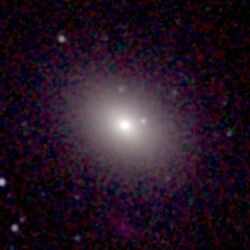Astronomy:NGC 7049
| NGC 7049 | |
|---|---|
 NGC 7049 - image from the Hubble Space Telescope's Advanced Camera for Surveys | |
| Observation data (J2000 epoch) | |
| Constellation | Indus |
| Right ascension | 21h 19m 00.25s[1] |
| Declination | −48° 33′ 43.24″[1] |
| Redshift | 2285 km/s[1] |
| Distance | 100 Mly[2] |
| Apparent magnitude (V) | 10.7[1] |
| Characteristics | |
| Type | S0 |
| Size | ~150,000 ly[2] |
| Other designations | |
| ESO 236-1,[3] PGC 66549[1] | |
NGC 7049 is a lenticular galaxy[1] that spans about 150,000 light-years and lies about 100 million light-years away from Earth[2] in the inconspicuous southern constellation of Indus.
NGC 7049's unusual appearance is largely due to a prominent rope-like dust ring which stands out against the starlight behind it. These dust lanes are usually seen in young galaxies with active star-forming regions. NGC 7049 shows the features of both an elliptical galaxy and a spiral galaxy, and has relatively few globular clusters, indicative of its status as a lenticular type.[4][citation needed] NGC 7049 is the brightest (BCG) of the Indus triplet of galaxies (NGC 7029, NGC 7041, NGC 7049),[5] and its structure might have arisen from several recent galaxy collisions. Typical BCGs are some of the oldest and most massive galaxies.[6][dubious ]
References
- ↑ 1.0 1.1 1.2 1.3 1.4 1.5 "NASA/IPAC Extragalactic Database". Results for NGC 7049. http://nedwww.ipac.caltech.edu/.
- ↑ 2.0 2.1 2.2 "Unusual Dusty Galaxy NGC 7049". http://apod.nasa.gov/apod/ap090408.html.
- ↑ "SIMBAD Astronomical Database". Results for NGC 7049. http://simbad.u-strasbg.fr/Simbad/.
- ↑ The Astronomical League
- ↑ "NGC 7049, an unusual galaxy in Indus" (in nl-NL). Anne's Astronomy News. 2012-08-05. http://annesastronomynews.com/photo-gallery-ii/galaxies-clusters/ngc-7049/.
- ↑ Nemiroff, R.; Bonnell, J., eds (8 April 2009). "Unusual Dusty Galaxy NGC 7049". Astronomy Picture of the Day. NASA. https://apod.nasa.gov/apod/ap090408.html.
External links
 |


